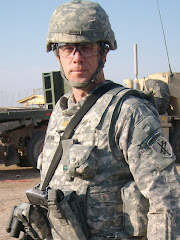Combat Lifesaver was taught by our own resident LPN while we were out on our training exercise, living in tents, in a Iraq-like operating base. This training gives every Soldier the absolute necessary skills to provide immediate care under fire. If the wounded Soldier's buddies can stop traumatic bleeding and start an intravenous line then a Soldier stands a 97% to 98% chance of survival if they reach the combat hospital.
The classroom instruction is very hands on. It teaches the latest in bandages, hemostat powder (a chemical agent that when introduced to a profuse bleeding wound almost immediately clots it - to include severed arteries), relieving collapsed lungs, and how to start an IV. And as part of the practical exercise and final exam Soldier have to do a IV "stick" on a live person.
Breathe deep. Prep the arm. Find the vein. Clean, sanitize, and prepare the area. Breathe deep again. Take out the needle and catheter. Breathe deep again. Introduce the needle and slide in the catheter. Secure, seal, and start a saline solution. Exhale.
Convoy live fire is another intimidating training event but for a whole different set of reasons than Combat Lifesaver. Six vehicles travel down a winding road while the machine gunner scans for targets to engage with live ammunition.
This training takes several days of preparation to execute. First, all of the gunners need to qualify on the firing range with their assigned weapon. Second, all of the drivers need to go through driver's training and learn the particulars of operating a two ton truck in adverse conditions. Next, the entire convoy practices the range using blanks so they know when and where to aim - and when and where not to aim.
Finally, on the last day, there is an extensive safety briefing followed immediately by the convoy briefing. Each truck has a safety officer who rides in the vehicle. They watch the machine gunners throughout the entire event.
As we rolled out and made the first turn the targets popped up and we immediately engaged by six separate gunners, each throwing rounds down range at rate of 200-300 per minute. From my vantage point, everyone followed their instructions and the training was over far too soon.


All is well here. We are getting a little stir crazy from living on top of one another and are looking forward to our pass in twelve days.


All is well here. We are getting a little stir crazy from living on top of one another and are looking forward to our pass in twelve days.




No comments:
Post a Comment